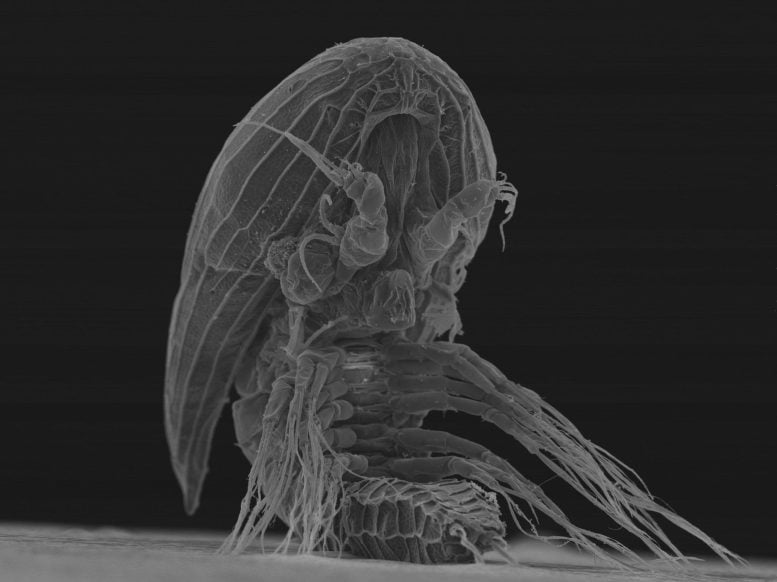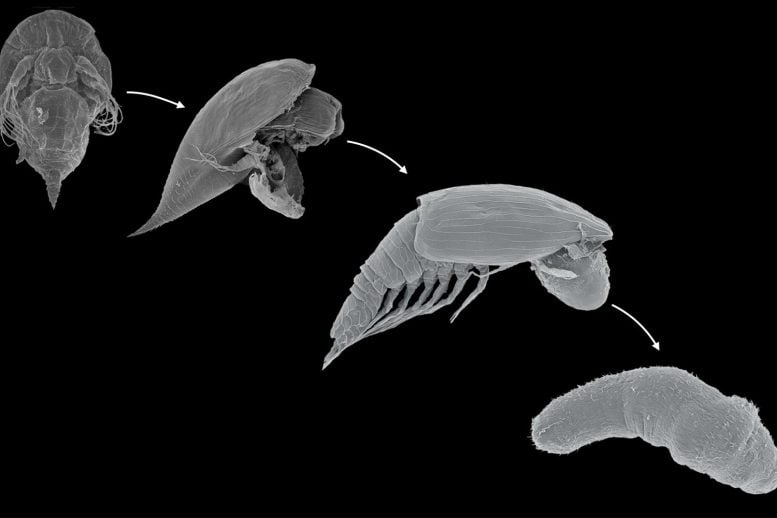
Posted on 09/04/2025 5:48:46 AM PDT by Red Badger

Facetotectans (aka y-larvae) have been a mystery since their discovery in the 1800s. Scientists are unsure of what they grow up to become, but we now know where these crustaceans fit in the tree of life. This image shows a cypris larvae, or y-cyprid. Credit: Niklas Dreyer Y-larvae, mysterious crustaceans related to barnacles, may be parasitic and are key to understanding barnacle evolution.
When most people think of barnacles, they imagine shell-like organisms clinging to boats, docks, or even whales. Yet some barnacles go far beyond passive attachment — they can actually invade and take over their hosts.
“Instead of gluing themselves to a rock or something, they glue themselves to a host, often a crab, and they inject themselves into that host, and live their entire life as a root network growing through their host. It’s almost like a fungal network or plant root system. They have no real body in the way that we think of animal bodies,” explains James Bernot, an assistant professor in the Department of Ecology and Evolutionary Biology at UConn.
Bernot and an international team of collaborators — including lead author Niklas Dreyer from the Natural History Museum of Denmark and Biodiversity Research Center Academia Sinica in Taiwan, Jørgen Olesen from the Natural History Museum of Denmark, Gregory Kolbasov from Moscow University, Jens Høeg from the University of Copenhagen, and Ryuji Machida and Benny Chan from the Biodiversity Research Center Academia Sinica — recently published a study in Current Biology on a puzzling group of crustaceans that may help resolve one of marine biology’s enduring mysteries.
The mystery of y-larvae
Barnacles are crustaceans, like crabs and shrimp, and have evolved unusual survival strategies. After a free-swimming larval phase, they spend the rest of their lives permanently attached to a chosen surface.
One especially mysterious group, known as “y-larvae” or Facetotecta, looks like juvenile barnacles. They have been documented in plankton samples since the 1800s, but no one has ever identified their adult stage. Bernot notes that this unresolved question remains central, though the team’s new research brings science closer to an answer.
To investigate where y-larvae belong on the crustacean family tree, the researchers gathered more than 3,000 specimens and examined their genes by sequencing the transcriptome — the set of expressed RNA molecules that reflects which genes are active.
Genetic analysis and hidden lives
“We were finally able to confirm, in the realm of big data science, that they are, in fact, related to barnacles, but they aren’t closely related to any of the other parasitic barnacles. This was interesting to test by building a giant tree of life for all the crustaceans, then adding this little branch of y-larvae, this very unknown group, to that bigger tree, and we saw that they are related to barnacles, but more as distant cousins,” says Bernot.
Though not closely related to parasitic barnacles, these crustaceans are also likely parasitic because they have some structures in common with their parasitic cousins, says Bernot, including antennae with claws that may be used to hook onto their host.

The Lifecycle of Y Larva to Ypsigon - This image shows the lifecycle of y-larvae from y-nauplius, to y-cyprid, to ypsigon (the last known stage), which is a worm-like stage that emerges from the previous larval stage if the y-cyprid is exposed to crustacean molting hormones. The researchers believet his worm-like stage is probably parasitic and would borrow into a host. Each is about 100 micrometers long (1/10 of a millimeter). Credit: Niklas Dreyer
===============================================================
“One of the best pieces of evidence we have that y-larvae become parasitic is that if we expose them to crustacean growth hormone, they will hatch out of their little swimming larval shape into a small slug-like body, which is similar to what parasitic barnacles do when they enter a host,” says Bernot. “The fact that if we give them hormones, they also molt into a slug-like thing, suggests they go on to be parasitic somewhere, but we still don’t know what host they end up in. Being hidden inside another animal’s body could explain why we haven’t found the adult stage of y-larvae yet.”
Although these crustaceans are unusual and largely unknown with only 17 species described so far, Bernot says some of his co-authors found more than 100 new and different species from a single harbor in Japan. There is more to learn about these enigmatic animals.
Evolutionary strategies and ecosystem roles
“We were finally able to confirm, in the realm of big data science, that they are, in fact, related to barnacles, but they aren’t closely related to any of the other parasitic barnacles. This was interesting to test by building a giant tree of life for all the crustaceans, then adding this little branch of y-larvae, this very unknown group, to that bigger tree, and we saw that they are related to barnacles, but more as distant cousins,” says Bernot.
Although they are only distantly related to parasitic barnacles, the evidence suggests y-larvae are also parasitic. They share certain traits with parasitic barnacles, including clawed antennae that may help them latch onto a host.
“One of the best pieces of evidence we have that y-larvae become parasitic is that if we expose them to crustacean growth hormone, they will hatch out of their little swimming larval shape into a small slug-like body, which is similar to what parasitic barnacles do when they enter a host,” says Bernot. “The fact that if we give them hormones, they also molt into a slug-like thing, suggests they go on to be parasitic somewhere, but we still don’t know what host they end up in. Being hidden inside another animal’s body could explain why we haven’t found the adult stage of y-larvae yet.”
Despite being poorly understood, with only 17 described species, y-larvae may be far more diverse than previously thought. Bernot points out that some of his colleagues identified more than 100 distinct species from just a single harbor in Japan, suggesting much remains to be discovered about these unusual animals.
Ingenious barnacle adaptations
Different species of barnacles use different strategies when they become sessile adults. Besides living on inanimate objects, those that live on animals like whales are not considered parasitic because they are essentially hitching a ride and do not feed on their host. Others attach to the host and have structures that they use to feed on the host. Understanding the evolution of these different strategies is important, and Bernot says that a project they are currently working on involves building the evolutionary tree of all barnacles to observe and understand some of the evolutionary patterns.
“A big question is, what is it about barnacles that has given them so much variability over evolutionary time to take on so many different shapes and forms and lifestyles? They have come up with incredibly ingenious strategies for making their ways of life, and often their ways of life seem very bizarre to us, but they have clearly been very successful,” says Bernot. “These animals have been around for hundreds of millions of years and there are several thousand species of them, so they have come up with some really amazing solutions to complex problems.”
Some of those solutions could also help humans. For example, Bernot says, there is a lot of interest in trying to better understand barnacle glues.
“They glue themselves to docks, they glue themselves to boats, and that is a problem. The Navy spends millions of dollars on additional fuel because barnacles on their ships cause additional drag. Also having more powerful glues that can dry underwater would be very useful for mechanical reasons, but maybe also for dentistry and things like that,” says Bernot. “There could be a lot of applications if we can better understand some of these amazing solutions that barnacles have evolved.”
Reference:
“Phylogenomics of enigmatic crustacean y-larvae reveals multiple origins of parasitism in barnacles”
by Niklas Dreyer, James P. Bernot, Jørgen Olesen, Gregory A. Kolbasov, Jens Thorvald Høeg, Ryuji J. Machida and Benny K.K. Chan, 21 July 2025, Current Biology.
DOI: 10.1016/j.cub.2025.06.007

Pretty cool!
Glad this was figured out, sometimes these guys couldn't hit the broad side of a barnicle. See, it really is all in the setup.
Hillary’s Mao suits
Larvae From the illusive bear-man-pig. They shoulda asked Al Gore. He could told ‘em and saved them a lot of trouble.
Disclaimer: Opinions posted on Free Republic are those of the individual posters and do not necessarily represent the opinion of Free Republic or its management. All materials posted herein are protected by copyright law and the exemption for fair use of copyrighted works.